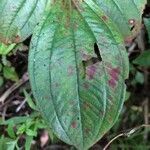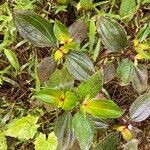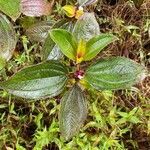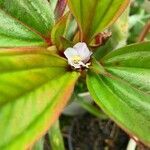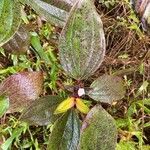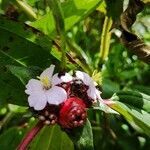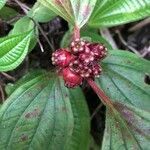Leaf-lamina (4)7–15(22) x (2)3–8(13) cm., elliptic or ovate-elliptic, acute at the apex, cuneate or rarely roundish at the base, entire, membranous, dark green above, lighter beneath, ± strigose on both faces, the hairs short, appressed on the upper face, sparser and subappressed on the lower, longitudinally 5–7-nerved, these nerves rather slender, impressed above, prominent beneath, the transverse ones ± obliquely ascending, conspicuous mainly beneath; petiole 1·2–4(5) cm. long, furrowed above, strigose.
A herb or small shrub. It grows 2 m tall. The stems are thick and square. They are covered with bristles. The leaf stalks are 1-4 cm long. The leaves are opposite and 5-15 cm long by 3-7 cm wide. They are hairy. The flower petals are 6-10 mm long. They are white. The fruit are 10 mm long by 6 mm wide. Fruit contain soft white sections. The seeds are in a white pulp. The seeds are small and 0.6 mm long.
Flowers numerous, in dense headed inflorescences; outer bracts completely foliaceous or with a foliaceous apex, acute, dorsally appressed-strigose, the inner ones subcircular to obovate, apiculate to obtuse, coriaceous to chaffy or scarious, glabrous.
Branches sharply 4-angled or slightly 4-winged, with furrowed faces, sparsely strigose, with short stiff appressed purplish bristles, denser towards the apex.
Receptacle 6–9 x 4–5 mm., ovoid, with 1(2) rings of bristles on the upper part, the lower ring, when present, usually incomplete.
An erect or climbing succulent perennial herb or a lax shrub up to 1·2(2·5) m. high, dark green, sometimes suffused reddish.
Anthers 4–5 mm. long; pedoconnective 0·5–0·75 mm. with the basal appendage deeply 2-lobed, the lobes obtuse.
Fructiferous receptacle 15–16 x 10–12 mm., purple or purplish-brown.
Petals 6–10 mm. long, pale mauve or pink.
Sepals 3·5–5 x2–3 mm., triangular, acute.
